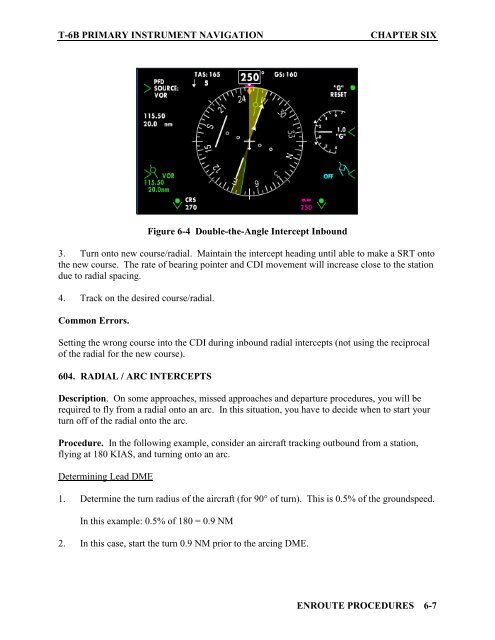Flight Training Instruction - Cnatra - U.S. Navy
Flight Training Instruction - Cnatra - U.S. Navy
Flight Training Instruction - Cnatra - U.S. Navy
Create successful ePaper yourself
Turn your PDF publications into a flip-book with our unique Google optimized e-Paper software.
T-6B PRIMARY INSTRUMENT NAVIGATION CHAPTER SIX<br />
Figure 6-4 Double-the-Angle Intercept Inbound<br />
3. Turn onto new course/radial. Maintain the intercept heading until able to make a SRT onto<br />
the new course. The rate of bearing pointer and CDI movement will increase close to the station<br />
due to radial spacing.<br />
4. Track on the desired course/radial.<br />
Common Errors.<br />
Setting the wrong course into the CDI during inbound radial intercepts (not using the reciprocal<br />
of the radial for the new course).<br />
604. RADIAL / ARC INTERCEPTS<br />
Description. On some approaches, missed approaches and departure procedures, you will be<br />
required to fly from a radial onto an arc. In this situation, you have to decide when to start your<br />
turn off of the radial onto the arc.<br />
Procedure. In the following example, consider an aircraft tracking outbound from a station,<br />
flying at 180 KIAS, and turning onto an arc.<br />
Determining Lead DME<br />
1. Determine the turn radius of the aircraft (for 90° of turn). This is 0.5% of the groundspeed.<br />
In this example: 0.5% of 180 = 0.9 NM<br />
2. In this case, start the turn 0.9 NM prior to the arcing DME.<br />
ENROUTE PROCEDURES 6-7
















